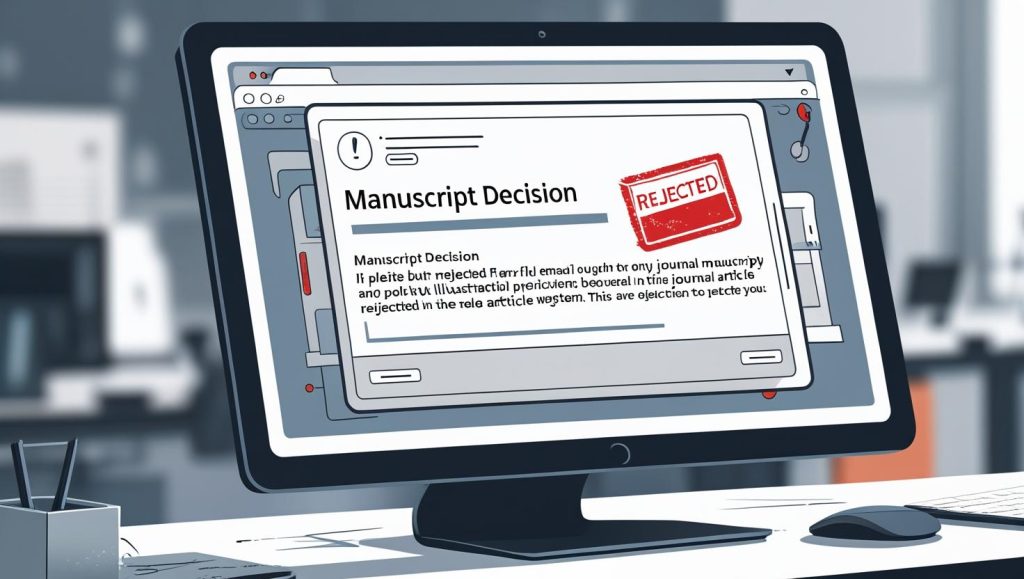The immediate rejection of a scientific article is one of the most frustrating experiences for those starting on the path to scientific publication. Receiving an email with a brief notification stating that “the article has been rejected without peer review” is not a pleasant experience. Known as desk rejectionthis is sometimes perceived as an arbitrary decision, but in the vast majority of cases, it is based on clear criteria that can be avoided.
From my experience as a scientific editor, there are three key dimensions reviewed at this initial stage: the ethical, technical, and content dimensions. Recognizing and addressing each of these can determine whether the process advances or is halted from the outset.
1. Editorial ethics: a non-negotiable condition
The first filter that every article submitted to a scientific journal undergoes is the ethical filter. Before assessing the relevance of the topic or the methodological quality, editors verify that the work complies with the principles of academic integrity.
This involves verifying that there is no plagiarism or self-plagiarism, that the content does not include sensitive information without ethical approval, and that the images or figures used do not infringe copyright. Keep in mind that many journals utilize advanced software to detect these issues promptly. A growing trend is the increasing use of artificial intelligence to produce tex. When a scientific article's language has rigid structures or lacks contextual flow, it can raise doubts that it was generated without enough human oversight.
Additionally, all authors must be properly registered at the time of submission. Intentionally or unintentionally omitting a co-author, or adding one later without a valid reason, can affect the transparency of the process. If the editor discovers that only one author submitted without including the others in the system metadata, the article is likely to be rejected on ethical grounds.
2. Technical criteria: the art of respecting editorial standards
Once the ethical issue has been resolved, the next step is to ensure the article meets the journal's technical and formal requirements. Although this stage may seem purely administrative, it is one of the most common reasons for immediate rejection, even when the content is promising.
A common mistake is submitting the article to the wrong section. Many journals organize their content by subject area or type of contribution (original articles, reviews, short articles, etc.), and choosing the incorrect section damages the evaluation of the text.
Another common cause is the improper formatting of references. Although it may seem like a small detail, not adhering to the required citation style (APA, Vancouver, Chicago, among others) shows a lack of attention to basic standards.
The absence of key elements, such as the title, abstract, and keywords, in the additional language required is also frequently seen. For example, if the journal mainly publishes in Spanish or Portuguese, and the article is submitted in one of these languages, the title, abstract, and keywords are likely needed in well-written English. Skipping this step not only risks rejection but can also reduce the article's future visibility.
The lack of anonymity in articles where double-blind review is required is another important factor. Including names, institutional affiliations, or references that reveal the author's identity is an apparent reason for rejection, as it compromises the unbiased review process.
Finally, some journals require additional documents during submission, such as statements of authorship, transfer of rights, or ethical certifications. If these files are not included, the submission is considered incomplete and is automatically rejected.
3. Content and thematic relevance: knowing whether the article “fits” the journal
The third dimension analyzed is the most academic of all: content. Here, the editor assesses whether the article is relevant to the journal's thematic focus and if its methodological and conceptual approach aligns with the standards it upholds.
A common mistake is submitting work that is clearly outside the thematic scope. This happens, for example, when educational research is sent to a journal focused on bibliometrics or when a local case study is submitted to a publication with an international focus.
It is also common for authors to be unaware of specific methodological requirements. Some journals do not accept literature reviews, exploratory studies, or qualitative research; others, however, favor them. The problem occurs when authors “try their luck” and hope that their approach will be accepted as an exception, which rarely happens.
Another important point is the quality of the abstract and references. Although many assume the editor will read the entire article before deciding, the reality is that the initial decision is often based on the abstract and the list of references. A poorly written, confusing, or overly technical abstract can cause the editor to reject the article without giving it a chance. The same applies when references are outdated, irrelevant, or not related to the field of study.
When there is any doubt about the relevance of the article, it is perfectly valid and recommended to contact the journal with a preliminary query. This saves time and effort for both parties and shows the author's seriousness.
First impressions count: the article is your cover letter
A widely recognized principle in marketing states that “there is no second chance to make a good first impression.” In the publishing world, this is an unavoidable truth. The article you submit to a journal is, in effect, your first introduction to the scientific community. It is not enough to have valuable content; it’s essential that the content is well structured, follows the rules, and conveys professionalism.
Using the templates that many journals provide is a great way to make sure you meet all important requirements. These templates not only show the format but also the section order, approximate length, and editorial details that help with evaluation. Likewise, carefully reviewing the instructions for authors before clicking “submit” is not just bureaucratic but an important step to avoid immediate rejection by the editors.
Recommendations for authors
- Use free similarity detection tools before submittingThis helps you identify unintentional textual matches. It also allows you to correct or paraphrase passages and ensure your writing is original, ethical, and transparent.
- Ask a co-author or colleague for a formal review of the article. Before submitting the article, it's very helpful to have someone else review technical details such as document formatting, section organization, adherence to editorial guidelines, citation style, and overall consistency. This double review can help catch omissions that the author might overlook when reading their own work.
- Contact the editorial office if you have specific questions. They are there to help you, not distant entities. If you need guidance on required documents, section selection, format, or file submission, writing a brief and
- Ask the editor if your article is suitable for the journal. If you're unsure whether the thematic or methodological focus of your article aligns with the publication, even early in the writing process, it's helpful to send a preliminary inquiry. This is especially advisable if the journal has very specific guidelines or if you're using methodologies that might not be accepted.
- Review the terms of use if you include images or figures from third parties. All previously published images, including tables, diagrams, or graphs, must have the proper authorization or license. Before reusing any visual resources, verify whether formal permission is needed or if attribution is enough, depending on the license type.
- Upload complete metadata for all authors from the beginning. Some articles are rejected because not all co-authors are listed on the editorial platform at submission. This omission can have serious ethical effects. Ensure each author is properly registered with their affiliation, email address, and, if available, their ORCID identifier.
- Ensure you submit your article to the appropriate section. Many journals have different sections for various types of articles or topics. Submitting your work to the wrong section could cause delays or automatic rejection. Carefully read the editorial descriptions for each section before submitting.
- Follow the templates and formats provided by the journal. If the publication offers a model or template for articles, it is essential to use it. These formats usually help streamline the review process and ensure that no important elements are missing, such as abstracts, keywords, acknowledgments, or ethical statements.




